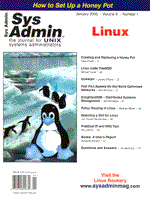
Questions and Answers
Jim McKinstry
enscript -2rG <file1> <file2> This will print two pages on one sheet (-2), using landscape mode (-r), with “fancy headers” (-G). “Fancy headers” can be configured to print what you need. Check out the man page (one location is http://www.engr.utk.edu/ecc/sw/misc/enscript/enscript.html) for more details.
vxdump -0 /dev/rmt/0n /backup vxdump -0 /dev/rmt/0n /dumps When I tried to restore it, it says this is not a valid vxdump, even though the vxdump logs says it was done successfully. Any help will be appreciated.
vxdump -0f /dev/rmt/0n /backup vxdump -0f /dev/rmt/0n /dumps The -f flag defines which tape device vxdump should use. If you leave the -f flag off, it will try to dump to the default tape device /dev/rmt/0m. You may also want to confirm that the /dev/rmt/0n is a real device. If it isn't, and you use vxdump -0f /dev/rmt/0n /backup you will find that you dumped /backup to a file called /dev/rmt/0n, not the tape device.
Edit /etc/init.d/sysetup and uncomment the following lines at the end of the file:
#if [ ! -d /var/crash/'uname -n' ] #then mkdir -m 0700 -p /var/crash/'uname -n' #fi # echo 'checking for crash dump...\c ' #savecore /var/crash/'uname -n' # echo '' Have Sun check for any patch that may address random reboots. I once had a SunOS4.1.3 system that would crash when the workload got too heavy. Sun supplied a patch and the problem went away. You may also want to call SUN and have them start swapping out hardware. I've seen random reboots caused by bad memory, bad motherboards, etc.
00 23 * * * pax_command > /log/home.'/usr/bin/date +\%y\%m\%d'.pax This will run your pax_command every night at 11:00p.m. and send the output to /log/home. 991012.pax (if it was run on October 12, 1999). Don't forget the “\” in front of the “%” in the date command!
• Saves current /etc/inet/hosts file information in /etc/inet/hosts.saved. • Restores the default /etc/inet/hosts file. • Removes the default hostname in /etc/hostname.??[0-9] and /etc/nodename. • Removes the default domainname in /etc/defaultdomain. • Restores the timezone to PST8PDT in /etc/TIMEZONE. • Disables the Network Information Service (NIS) and Network Information Service Plus (NIS+) if either NIS or NIS+ was configured. • Removes the entries for this host in /etc/net/*/hosts. • Removes the password set for root in /etc/shadow. • Removes the file /etc/.rootkey. • Executes all system configuration applications. These applications are defined by prior executions of a sysidconfig -a application. (See sysidconfig(1M)). When sys-unconfig is run, all system configuration applications are passed one argument, -u.
When sys-unconfig is finished, it performs a system shutdown. When the system reboots, you will be prompted for all of the information that you were prompted for when you first installed the OS. Also note that if you had a lot of hosts defined in etc/inet/hosts, you can get them from /etc/inet/hosts.saved. If you have the time, patience, and really want to learn more about the system, do this by hand (i.e., edit each file with vi and make the changes).
On the Solaris server system:
share -F nfs rw=servername /cdrom <enter> I checked the /etc/dfs/sharetab file and the entry for /cdrom was present. On the SunOS client system:
mkdir /mountpoint <enter> mount servername:/cdrom /mountpoint <enter> I checked the /etc/mtab file and saw the entry for servername:/cdrom and the mount point /mountpoint.
cd /mountpoint <enter> I did not see the CD-ROM files in the /mountpoint directory. I did see an empty directory called /cdrom/cdrom0. Did I make the mistake of not starting the nfsd and the mountd deamons on the server and client, respectively? Or you could not mount devices like CD-ROM or tapes? I know that I can't use NFS to mount a tape, but I know one person who has NFS and mounted a CD-ROM in his network.
share -F nfs -o ro=servername /cdrom/cdrom0 You also need to verify that the NFS server is running on the system that the CD-ROM is on:
ps -ef | grep nfs This should return something like: root 541 1 0 16:55:25 ? 0:00 /usr/lib/nfs/lockd root 539 1 0 16:55:25 ? 0:00 /usr/lib/nfs/statd root 966 1 0 16:56:14 ? 0:00 /usr/lib/nfs/nfsd -a 16 root 964 1 0 16:56:14 ? 0:00 /usr/lib/nfs/mountd If nfsd and mountd are not there, try running /etc/rc3.d/S15nfs.server start. Since you said that there is an NFS entry for CD-ROM in /etc/dfs/sharetab, nfsd and mountd should start. Once the NFS server is started, try your mount command on the client again. Check that /CD-ROM is mounted by running the df command.
1. Dial-in to ISP from Linux. 2. Have the Windows box use the Linux box as its router to the Internet. For a step-by-step guide, check out:
http://www.timhiggins.com/ppd/sharing.html. (Thanks to Amy Rich for this link!) You will have to run some sort of NAT (Network Address Translation) software on the Linux box. Check out:
http://www.uq.net.au/~zzdmacka/the-nat-page/nat_unix.html for a lot of different options. For a better understanding of NAT, check out:
http://www.uq.net.au/~zzdmacka/the-nat-page/natinformation.html.
About the Author
Jim is a Technical Analyst specializing in UNIX. He has worked for IBM, Rite Aid, EDS, and is currently working for Sprint Paranet. He can be reached at: jrmckins@yahoo.com.
|